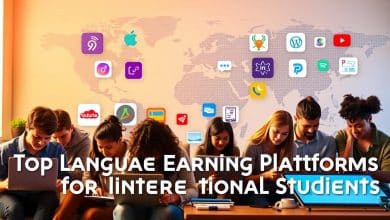Best Free Online Platforms for Learning Business and Finance Skills
Digital education has revolutionized access to professional development. Today, aspiring entrepreneurs and career-driven professionals can build expertise without financial constraints. Platforms like Coursera host over 1,162 no-cost courses in English alone, covering essentials like data analytics and digital marketing. Specialized programs such as Google’s Foundations of Digital Marketing and E-commerce deliver industry-specific knowledge in under six hours.
Diverse language options make these resources globally accessible. Spanish, French, and Arabic speakers gain equal access to critical skills, while MOBI’s entrepreneurship courses provide templates and checklists for real-world application. Courses like Starting a Business and Growing a Business simplify complex concepts through structured, self-paced lessons.
What sets modern education tools apart is their focus on career advancement. Many programs offer credentials from institutions like the University of Illinois or IBM. These certificates validate skills for resumes and LinkedIn profiles. Interactive elements—such as Power BI simulations in the From Excel to Power BI course—bridge theory and practice.
Whether mastering financial analysis or launching a startup, today’s learners benefit from flexible, results-driven formats. Short 2-hour modules cater to busy schedules, while multi-month programs allow deeper exploration. This blend of accessibility and quality redefines professional growth in the digital age.
Introduction to Online Learning for Business and Finance
Access to expert knowledge no longer requires physical classrooms or hefty tuition fees. Over 1,100 digital programs now deliver career-focused training through interactive formats. This shift empowers professionals globally to build skills during lunch breaks or while commuting.
The Evolution of Free Online Courses
Early digital classes offered basic video lectures. Today’s programs feature hands-on simulations and peer discussions. Over 800 structured courses now include real-world projects and industry tool access. Learners can choose from:
| Format | Options Available | Average Duration |
|---|---|---|
| Guided Projects | 264 | 1-2 hours |
| Specializations | 51 | 3-4 weeks |
| Certificates | 28 | 3-6 months |
This variety supports different goals, whether mastering Excel formulas in an afternoon or completing six-month leadership development tracks.
Benefits of Accessible Business Education
Geographical barriers dissolve when a student in Nairobi uses the same case studies as one in New York. Over 70% of programs now work on mobile devices, letting users practice financial analysis during downtime. Immediate application separates modern education from theoretical models – learners often finish courses with completed business plans or marketing strategies.
Skill validation matters too. Credentials from recognized institutions help professionals stand out in competitive job markets. These advancements create equal opportunities for career growth across economic backgrounds.
Top Courses and Resources for Business Mastery
Modern professionals need skills that adapt to market changes. Leading educational providers now deliver targeted programs combining academic rigor with practical application. These resources cater to diverse career stages, from foundational concepts to advanced technical expertise.
Featured Courses from Leading Institutions
Industry giants and universities offer specialized training paths. IBM’s Python for Data Science, AI & Development teaches coding essentials through real-world case studies. The University of Pennsylvania’s English for Career Development enhances communication skills for global teams.
MOBI structures entrepreneurial education through three core programs: Starting a Business, Managing a Business, and Growing a Business. Their accelerated options like the Sales and Marketing Badge Course provide tactical frameworks for immediate implementation.
Certifications and Skill Development
Credentials from institutions like Microsoft and Google validate expertise in competitive fields. Coursera’s Getting Started with Microsoft Excel includes a shareable certificate upon completion. These proofs of competency help professionals negotiate salaries or transition roles.
Hands-on projects bridge theory and practice. The University of Maryland’s cybersecurity course challenges learners to create risk assessment plans. Such portfolio-ready work demonstrates problem-solving abilities to potential employers.
Exploring free business learning platforms
Innovative tools are reshaping how professionals engage with educational content. Modern systems combine powerful technology with intuitive design, creating environments where skill development becomes effortless.
Core Features and Tools
Leading solutions offer drag-and-drop course builders that simplify content creation. These systems support multiple media formats, from interactive quizzes to video case studies. A centralized dashboard lets instructors track progress across all participants.
| Feature Category | Key Components | Deployment Options |
|---|---|---|
| Content Delivery | Video libraries, PDF resources | Cloud-based |
| Assessment Tools | Auto-graded quizzes, peer reviews | Self-hosted |
| Analytics | Engagement metrics, completion rates | Mobile apps |
Advanced systems automatically generate compliance reports and suggest personalized learning paths. This automation saves hours compared to manual tracking methods.
User Experience and Flexibility
Mobile-responsive designs adapt to any screen size, maintaining functionality during commutes or coffee breaks. Progress trackers visually map completed modules against remaining material.
Gamification elements like achievement badges create friendly competition among peers. Some systems feature adjustable timelines, letting users speed through familiar topics or linger on complex concepts.
Real-time feedback loops help learners correct mistakes immediately. This approach reduces frustration compared to traditional delayed grading systems.
Strategies to Get the Most Out of Free Learning
Mastering new skills demands more than enrollment—it requires smart strategy. Modern educational resources offer rich materials, but their impact depends on how learners engage with them.
Effective Study Techniques
Structured routines transform casual browsing into skill development. Setting fixed weekly study hours improves consistency, mirroring traditional classroom discipline. Tools like MOBI’s progress trackers help maintain momentum through visual milestones.
Active participation drives results. Summarizing key points after video lessons strengthens retention. Many students report better performance when applying templates to real-world scenarios during the learning process.
Diverse formats cater to individual preferences. Audio lessons during commutes or multilingual subtitles make content accessible across schedules. Case studies show learners using checklists complete projects 34% faster than those relying solely on theory.
Documenting achievements builds career capital. Portfolios showcasing certificates and completed projects demonstrate measurable growth. Networking through course communities often leads to mentorship opportunities, amplifying the value of the educational journey.
Comparing Learning Management and Business Platforms
Organizations now face critical decisions when selecting digital training solutions. Over 15 major systems dominate the market, each catering to specific operational needs. The right choice depends on team size, technical resources, and long-term growth plans.
Key LMS Features for Businesses
Enterprise solutions prioritize scalability and compliance. TalentLMS supports 300+ users with automated certification renewals, while Moodle requires manual setup but offers limitless customization. Core differentiators include:
| Feature | Corporate Leaders | Academic Focus |
|---|---|---|
| User Capacity | 500+ seats | Unlimited |
| Compliance Tools | HIPAA/GDPR ready | Basic reporting |
| Content Libraries | Industry-specific | General education |
| Support Model | 24/7 priority | Community forums |
Cloud-based systems like Thinkific simplify course creation with drag-and-drop editors. Self-hosted options demand IT expertise but provide deeper control over data security protocols.
Integration with Business Tools and Data
Seamless connectivity separates professional solutions from basic educational software. Google Classroom syncs with Workspace apps for real-time collaboration. TalentLMS connects to Salesforce CRM, updating lead records as teams complete sales training modules.
API capabilities vary widely. Open edX supports custom integrations through developer tools, while Schoology focuses on school information system compatibility. Decision-makers should verify authentication methods and data export formats before implementation.
Leveraging Data and Analytics in Business Education
Modern education systems thrive on measurable outcomes. Over 78% of leading programs now use analytical tools to refine course effectiveness. These systems track everything from module completion rates to skill application in real-world scenarios.
Transforming Insights Into Action
Advanced management systems convert raw numbers into strategic improvements. For example, heatmaps reveal which video segments students replay most, signaling complex topics needing clarification. “Analytics aren’t just charts—they’re compasses pointing to better learning experiences,” notes an IBM training architect.
Interactive dashboards simplify complex metrics. Color-coded progress bars show individual strengths versus group averages. This visual approach helps instructors spot trends without spreadsheet expertise. Real-time updates let teams adjust content as needs evolve.
Predictive models identify struggling learners early. Systems flag users who skip practice quizzes or take longer on assessments. Targeted support then arrives before frustration sets in, boosting completion rates by up to 40% in some programs.
| Metric Type | Traditional Analysis | Modern Approach |
|---|---|---|
| Engagement | Monthly reports | Live dashboards |
| Skill Gaps | Post-course surveys | AI-driven predictions |
| ROI Tracking | Manual calculations | Automated BI integration |
Integration with business tools creates workforce development insights. Sales training data might connect to CRM platforms, showing how skills impact deal closures. This end-to-end visibility helps organizations allocate resources effectively.
Conclusion
Modern professional development thrives on accessible, adaptable tools that empower career growth. The landscape of educational solutions now delivers enterprise-grade features through no-cost systems, bridging gaps between institutional resources and individual needs. Platforms like Knack demonstrate this shift, offering template-driven course creation and API integrations without coding requirements.
Choosing the right learning management system demands strategic evaluation. Scalability, security protocols, and mobile optimization prove critical for long-term success. Solutions must align with organizational workflows while supporting personalized skill development through analytics-driven insights.
Effective implementation hinges on three pillars: user-centric design, community engagement, and continuous adaptation. Systems enabling real-time progress tracking and certification options help learners demonstrate measurable competencies. As data visualization and AI-driven recommendations evolve, these tools will increasingly shape workforce readiness across industries.
The future of professional education lies in seamless integration between knowledge acquisition and practical application. By prioritizing flexible systems with robust support ecosystems, individuals and organizations can transform theoretical concepts into career-advancing results.
FAQ
How credible are certifications from online courses for career advancement?
Can these platforms integrate with tools like Excel or Tableau for practical training?
Are there options for learners with limited technical experience?
How do data visualization courses enhance decision-making skills?
What study techniques improve retention in self-paced courses?
Do learning management systems (LMS) support team collaboration features?
How secure is sensitive data when using cloud-based LMS tools?
Are mobile apps available for on-the-go learning?
Published on: 15 de August de 2025







